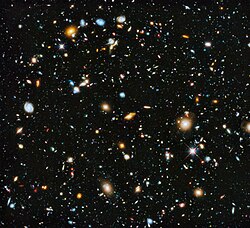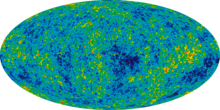Universe
From Wikipedia, the free encyclopedia
For other uses, see Universe (disambiguation).

The Hubble Ultra-Deep Field image shows some of the most remote galaxies visible with present technology, each consisting of billions of stars. The image's area of sky is very small - equivalent in size to one tenth of a full moon.[1]
| |
| Age | 13.799 ± 0.021 billion years [2] |
|---|---|
| Diameter | At least 91 billion light-years (28 billion parsecs) [3] |
| Mass (ordinary matter) | At least 1053 kg [4] |
| Average density | 4.5 x 10−31 g/cm3 [5] |
| Average temperature | 2.72548 K [6] |
| Main Contents | Ordinary (baryonic) matter(4.9%) Dark matter (26.8%) Dark energy (68.3%)[7] |
| Shape | Flat with only a 0.4% margin of error[8] |
The Universe is all of time and space and its contents.[9][10][11][12] The Universe includes planets, stars, galaxies, the contents of intergalactic space, the smallest subatomic particles, and all matter and energy. Theobservable universe is about 28 billion parsecs (91 billion light-years) in diameter at the present time.[3] The size of the whole Universe is not known and may be either finite or infinite.[13] Observations and the development of physical theories have led to inferences about the composition and evolution of the Universe.
Throughout recorded history, cosmologies and cosmogonies, including scientific models, have been proposed to explain observations of the Universe. The earliest quantitative geocentric models were developed byancient Greek philosophers and Indian philosophers.[14][15] Over the centuries, more precise astronomical observations led to Nicolaus Copernicus's heliocentric model of the Solar System and Johannes Kepler'simprovement on that model with elliptical orbits, which was eventually explained by Isaac Newton's theory of gravity. Further observational improvements led to the realization that the Solar System is located in a galaxy composed of billions of stars, the Milky Way. It was subsequently discovered that our galaxy is just one of many. On the largest scales, it is assumed that the distribution of galaxies is uniform and the same in all directions, meaning that the Universe has neither an edge nor a center. Observations of the distribution of these galaxies and their spectral lines have led to many of the theories of modern physical cosmology. The discovery in the early 20th century that galaxies are systematically redshifted suggested that the Universe is expanding, and the discovery of the cosmic microwave background radiation suggested that the Universe had a beginning.[16]Finally, observations in the late 1990s indicated the rate of the expansion of the Universe is increasing[17] indicating that the majority of energy is most likely in an unknown form called dark energy. The majority of mass in the universe also appears to exist in an unknown form, called dark matter.
The Big Bang theory is the prevailing cosmological model describing the development of the Universe. Space and time were created in the Big Bang, and these were imbued with a fixed amount of energy and matter; as space expands, the density of that matter and energy decreases. After the initial expansion, the Universe cooled sufficiently to allow the formation first of subatomic particles and later of simple atoms. Giant clouds of these primordial elements later coalesced through gravity to form stars. Assuming that the prevailing model is correct, the age of the Universe is measured to be 13.799±0.021 billion years.[2]
There are many competing hypotheses about the ultimate fate of the Universe. Physicists and philosophers remain unsure about what, if anything, preceded the Big Bang. Many refuse to speculate, doubting that any information from any such prior state could ever be accessible. There are various multiverse hypotheses, in which some physicists have suggested that the Universe might be one among many universes that likewise exist.[18][19]
| Part of a series on |
| Physical cosmology |
|---|
 |

